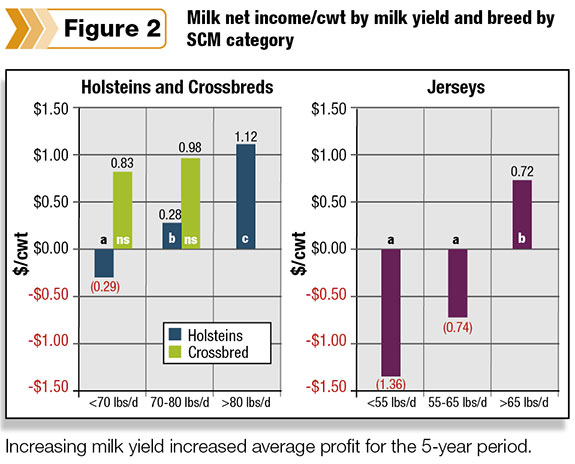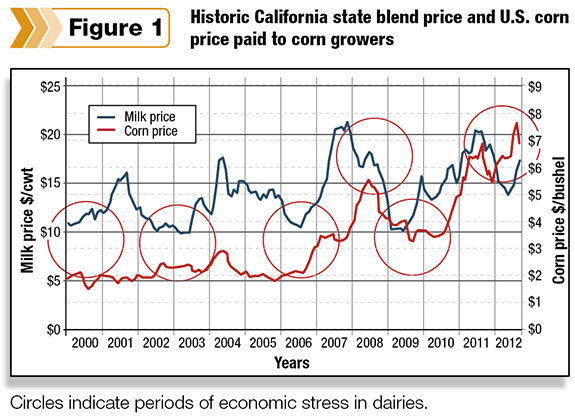Volatility has increased tremendously over the last 10 years in the dairy and grain industries, with milk price peaking every three years and coming to record highs (Figure 1).
This extreme market volatility in both milk and feed prices has stressed dairies across the country, resulting in emphasis on reducing costs whenever and wherever possible.
Cutting costs is generally a good idea provided milk yield is not sacrificed. Any cost-cutting, management or feeding decision made that lowers milk sales is likely to decrease the profitability of the herd.
Changes in the dairy economy motivated us to look into ways to assist dairymen in California to maintain profitability in difficult economic times.
The California Department of Food and Agriculture (CADFA) has collected cost of production information from several dairies across California on a quarterly basis for many years.
In a collaborative effort with the CADFA, we evaluated the cost of production on California dairies looking at financial and production trends that could lead to improved profitability.
We used a database consisting of around 150 herds each year from 2006 to 2010, close to 200,000 dairy cows. The database excluded organic herds due to differences in pricing relative to conventional dairies. Herds were categorized as Holsteins, Jerseys and crossbreds.
The herd size in analyses referred to both lactating and dry cows.
Profit on these dairies was defined as milk net income, consisting of mailbox price paid per hundredweight (cwt) less the total cost of producing a cwt of milk for each dairy each year. Total cost included feed, labor, herd replacement, operating and milk marketing cost.
It did not include managerâs salary or income from the sale animal with genetic purpose. Dry matter intake was calculated as the average amount of feed dry matter provided to the cows and solids-corrected milk (SCM) was calculated to 3.5 percent milkfat and 8.7 percent solids non-fat content.
Feed efficiency was calculated using the average SCM divided by average DMI per cow per day for the herd. Data were categorized by milk yield, herd size and feed efficiency and analyzed statistically relative to the financial data.
Besides analyzing differences among herds, changes within the herds over the five-year time period were analyzed. Per-year change in milk yield was correlated to per-year change in total cost per cwt for herds that were in the data-set all five years. Milk categories are expressed as SCM.
Milk yield and profitability
Total cost per cow per year increased in all breeds as milk yield increased. For example, in Holstein herds, it was as low as $1,500 in 2006 and as high as $2,000 per cow per year in 2009.
When the same data were analyzed per cwt of milk, the data has the opposite trend. As milk production increased, total cost per cwt decreased regardless of year or breed.
When categorized by milk production, Holstein herds producing 70 pounds or less per day averaged total cost per cwt of $14.97, while herds producing more than 80 pounds per day averaged $13.49 per cwt.
Jersey herds producing 55 pounds or less per day had a total cost per cwt of $17.67, while herds producing more than 65 pounds per day spent $2.09 per cwt less.
The data clearly show that as herds produced more milk per cow per day, total cost per cwt declined. Feed, labor, replacement and operational costs followed the same statistical trend.
This is due to the ability of herds producing more milk per cow to dilute the dairyâs fixed costs.

Milk net income per cwt (MNI) increased as milk yield increased ( Figure 2 ).
Holstein herds producing 70 pounds or less per day had an average MNI of -$0.29 per cwt, while herds producing more than 80 pounds per day netted $1.12 per cwt over the five-year period.
Jersey herds producing 55 pounds or less per day lost -$1.36 per cwt while herds producing more than 65 pounds per day gained $0.72 per cwt.
Crossbred herds producing 70 pounds or less per day had a MNI of $0.83, while herds producing more than 70 pounds per day had $0.98 per cwt.
The trend from low-producing to high-producing herds was similar across Holsteins and Jerseys.
Top-producing Holstein and Jersey herds have been profitable on average over the last five years, while low-producing herds have not. Interestingly, crossbred herds were profitable regardless of milk production but included only seven herds.
Herd size and profit
Larger herds can capitalize on economies of scale and dilute their costs of production by milking more cows. Pooled across all other variables, Holstein herds larger than 1,000 cows had significantly lower total cost of production and larger MNI per cwt than herds with fewer than 1,000 cows.
Herds with more than 2,000 cows were not statistically different than herds with 1,000 to 2,000 cows in total cost or income per cwt, although their total cost of production was a smaller number.
Across all other variables, Jersey herds larger than 500 cows had significantly lower total cost of production than herds with less than 500 cows. Herds with more than 500 cows had $1.70 lower total cost per cwt than herds with less than 500 cows.
Although not statistically different, herds with more than 2,000 cows had numerically lower total cost of production. Jersey herds larger than 2,000 cows had significantly higher milk net income ($0.84 per cwt) than herds with less than 2,000 cows, which averaged a $0.55-per-cwt loss.
Similar trends in costs and MNI by herd size occurred in each milk yield category. In each production category for Holstein herds, larger herds had decreased total cost of production per cwt. These data clearly demonstrate that larger herds within each milk production category made more profit per cwt.
However, increasing milk yield had a more significant response to profitability than herd size. Regardless of size, all herds producing more than 80 pounds per day were highly profitable over the five-year period.
Feed efficiency
Feed efficiency (FE) should be interpreted carefully, as these are field data â no orts or weigh-backs were measured. Intake was expressed as dry matter offered. When analyzed by year, larger FE was associated with smaller total cost per cwt regardless of breed or year.
For MNI, Holstein herds with the lowest FE lost $0.41 per cwt, while herds with the highest FE profited $0.87 per cwt. Similarly, Jersey herds with the lowest FE lost $1.16 per cwt, while herds with the highest FE profited $0.97 per cwt.
Clearly, one way of increasing profitability is by improving the FE of the herd. Therefore, careful consideration should be given when making changes in nutrition or management that affect FE or that change milk production.
Within-herds comparison
Herds that were in the study all five years were separated into a 108-herd dataset. Milk yield change (pounds per day) within herd over the five-year period was regressed on change in total expense per cwt.
Holstein herds with the same milk yield from 2006 to 2010 had an increased total cost of $0.34 per cwt per year. Herds that lost 1.5 pounds per cow per year of SCM in that period had an increased total cost of $0.60 per cwt per year or $3 per cwt in the five-year period.
However, herds that increased 1.5 pounds per cow per year milk yield had an increased total cost of just $0.25 per cwt per year or $1.25 per cwt over the five years.
These changes in milk production clearly indicate that as time progressed herds that kept improving had a better chance of remaining more profitable compared with herds that stayed the same or reduced their efficiencies.
It is evident the price of milk has a major significant impact on the profitability of dairies in California; however, dairies have little control over that. Considering factors that dairies can control, milk yield is a very important part of the profitability equation.
High-producing herds were predominantly profitable in good and poor economies regardless of herd size.
The data demonstrated that herds with higher milk yield maximized net income per cwt in years of high milk price and minimized losses in years of low milk prices. Increasing herd size improved the economic efficiency of herds in California, but milk yield per cow had a greater impact.
Therefore, the greatest opportunity to increase the likelihood of profitability on California dairies is to improve individual animal efficiency with higher yield and higher feed efficiency.
Focus on fundamentals such as cow comfort and increase herd size for efficiency taking advantage of economies of scale and volume.
Spend money wisely and use technologies that give evidence of economic return. Control the controllable and repeat this process for continuous improvement. PD
Greg Bethard is assistant director for dairy technology at G&R Dairy Consulting and Michael McGilliard is a professor emeritus in dairy management with Virginia Tech.

Luis A. Rodriguez
California Manager
Zinpro Performance Minerals





